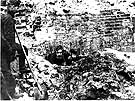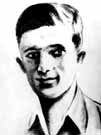
|
|
|

|

|

|

|
|
Click on an image to see a larger, more detailed picture.
|
|
|
|
|
| 1943: Death and Resistance |

|
pg. 449 |

|
|
|
|
| |
 A Jewish man is removed from his hidden bunker during the Warsaw Ghetto uprising. Even after the ghetto was razed, Jews attempted to hide from the Nazis. To counter these efforts, SS commander Jürgen Stroop ordered his soldiers to employ whatever means necessary to flush the Jews from their hiding places. The troops used flamethrowers, gas, and grenades to achieve their goals.
A Jewish man is removed from his hidden bunker during the Warsaw Ghetto uprising. Even after the ghetto was razed, Jews attempted to hide from the Nazis. To counter these efforts, SS commander Jürgen Stroop ordered his soldiers to employ whatever means necessary to flush the Jews from their hiding places. The troops used flamethrowers, gas, and grenades to achieve their goals.
Photo: Bildarchiv Preussischer Kulturbesitz / United States Holocaust Memorial Museum Photo Archive
|
 The Stroop Report was first published in 1960. The 75-page paper painstakingly describes the destruction of the Warsaw Ghetto and glorifies the author and commander Jürgen Stroop's role in the process. His daily entries and communiqués record the cold-blooded brutality he levied against Warsaw's Jews. On May 16, 1943, Stroop reported that the operation was complete and that "the Jewish Quarter of Warsaw is no more."
The Stroop Report was first published in 1960. The 75-page paper painstakingly describes the destruction of the Warsaw Ghetto and glorifies the author and commander Jürgen Stroop's role in the process. His daily entries and communiqués record the cold-blooded brutality he levied against Warsaw's Jews. On May 16, 1943, Stroop reported that the operation was complete and that "the Jewish Quarter of Warsaw is no more."
Photo: National Archives / United States Holocaust Memorial Museum Photo Archive
|
 Mordecai Anielewicz
Mordecai Anielewicz
Mordecai Anielewicz was the commander of the Warsaw Ghetto uprising. He personally led the attack against the Germans before being killed on May 8, 1943. When Germany invaded Poland, Anielewicz became active in the underground movement. As the Nazi campaigns against the Jews turned genocidal, Anielewicz organized an armed resistance movement. Returning to Warsaw in fall 1942, Anielewicz took command of the Jewish Fighting Organization (ZOB) and worked feverishly to secure weapons. During the mass deportations of January 1943, Anielewicz's group battled German troops in the streets. When a new wave of deportations began in April, Anielewicz and the ZOB launched a full-scale revolt. Shortly before his death, Anielewicz wrote: "My life's dream has come true. I have lived to see Jewish resistance in the ghetto in all its greatness and glory."
Photo: Bildarchiv Preussischer Kulturbesitz
|
|

|

|

|

|
 May 1, 1943: Many members of the Brody, Ukraine, Jewish community are killed at the Majdanek death camp.
May 1, 1943: Many members of the Brody, Ukraine, Jewish community are killed at the Majdanek death camp.
|
 May 1, 1943: Jewish writers and artists, inspired by the Warsaw Ghetto uprising, gather in the Vilna (Lithuania) Ghetto for an evening of poetry, with the hopeful theme "Spring in Yiddish Literature."
May 1, 1943: Jewish writers and artists, inspired by the Warsaw Ghetto uprising, gather in the Vilna (Lithuania) Ghetto for an evening of poetry, with the hopeful theme "Spring in Yiddish Literature."
|
 May 1, 1943: The Allies begin to push the Germans from Tunisia.
May 1, 1943: The Allies begin to push the Germans from Tunisia.
|
 May 1, 1943: German Minister of Propaganda Joseph Goebbels, reacting to the Jewish Warsaw Ghetto revolt, notes in his diary: "Heavy engagements are being fought there which led even to the Jewish Supreme Command's issuing daily communiques. Of course, this fun won't last very long. But it shows what is to be expected of the Jews when they are in possession of arms."
May 1, 1943: German Minister of Propaganda Joseph Goebbels, reacting to the Jewish Warsaw Ghetto revolt, notes in his diary: "Heavy engagements are being fought there which led even to the Jewish Supreme Command's issuing daily communiques. Of course, this fun won't last very long. But it shows what is to be expected of the Jews when they are in possession of arms."
|
 May 2, 1943: Four thousand Jews from Miedzyrzec Podlaski, Poland, are murdered at the Treblinka death camp.
May 2, 1943: Four thousand Jews from Miedzyrzec Podlaski, Poland, are murdered at the Treblinka death camp.
|
 May 2, 1943: At Luków, Poland, 4000 Jews are killed.
May 2, 1943: At Luków, Poland, 4000 Jews are killed.
|
|
|
|
|
| 1943: Death and Resistance |

|
pg. 449 |

|
|
The Holocaust Chronicle
© 2009 Publications International, Ltd.
|
|
